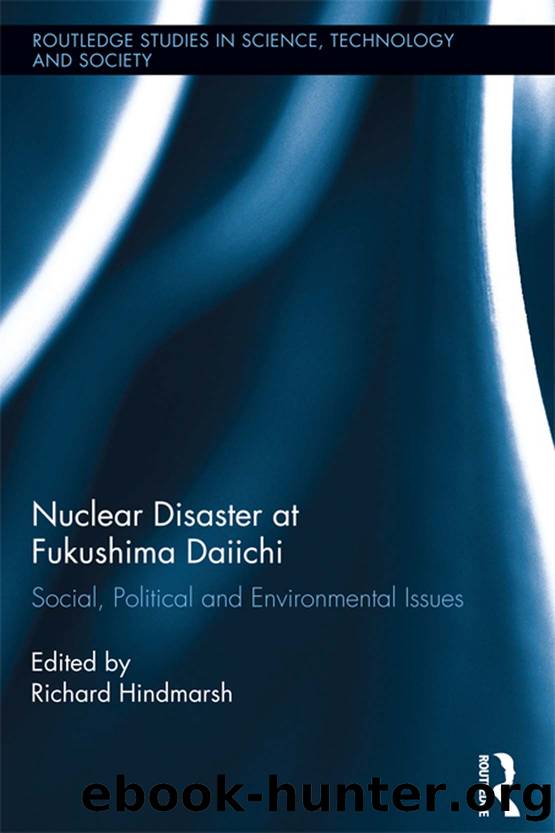Nuclear Disaster at Fukushima Daiichi: Social, Political and Environmental Issues by Richard Hindmarsh

Author:Richard Hindmarsh [Hindmarsh, Richard]
Language: eng
Format: epub
Tags: Political Science, Public Policy, General, American Government, National, Environmental Policy
ISBN: 9780415527835
Google: t0CYuAAACAAJ
Goodreads: 16233821
Publisher: Routledge
Published: 2013-01-15T11:43:12+00:00
HUMANITARIAN HACKERSPACE WORKSHOPS IN TOKYO
The transformation of consumers of data into public actors was done not only by data sharing practices but also through building and developing open source tools, as in the Tokyo Hackerspace workshops. The importance of the open source hardware as a novel response to the disaster was apparent from the online materials related to the Tokyo Hackerspace events (Akiba 2011, Reuseum 2011). Almost immediately after the Tohoku earthquake and tsunami, which informed Fukushima, and during the ensuing disasters, Hackerspace members held several meetings to discuss how to help affected areas. The first humanitarian hardware project of Tokyo Hackerspace, the Kimono Lantern Kit, was a solar rechargeable lamp originally designed as a decoration for gardens. It was quickly mass produced and distributed in areas suffering blackouts.
This form of local activism was later termed âHumanitarian Open Source Hardwareâ (Akiba 2011). The lantern project served as a model for developing the subsequent DIY radiation sensing devices of various DIY Geiger counters (e.g. iGeigie, the iPhone Radiation Dock, and the Ion Chamber Radiation Detector Kit). The following is a description of one of the first Hackerspace meetings, which demonstrates the close connection between attempts to design open source hardware tools and activist ambitions to help affected areas. It expresses the motivation and empathy mixed with very practical concerns on what is needed in terms of technical, financial, and other support:
In the hackerspace, we'll be holding our meeting tonight and will probably start hammering out plans to figure out how and where we can helpâ¦. So although it's outside the original sphere of intended use, it looks like the simple Kimono lanterns we designed can play a small role in providing comfort and at least give a small feeling of safety to people that are going through this horrific experienceâ¦. I've updated the files to v1.1 and the package includes the BOM and full gerbers. It's a turnkey package that can be taken and sent directly to the PCB fab. (Akiba 2011)
Bringing the open source lamp to the people in affected areas was thus not a simple utilitarian task but more an attempt to provide a feeling of safety after trauma, to give a feeling of personal control over the circumstances. It is an example of what is referred to as a âfetishâ function of humanitarian hardware, which is even more pronounced in the case of the DIY Geiger counters. Like indigenous culture fetishes, these objects have almost a âmagical powerâ to provide comfort in times of uncertainty and hazard. People monitoring radiation around their houses and neighborhood are aware that they are not protected from the physical effects of radiation but at least psychologically and mentally they feel protected from the uncertainty and chaos and hold onto the hope they can manage and improve their circumstances. The DIY radiation monitoring devices simply enabled a psychology of basic control and comfort (as well as practical outcomes), also related to a feeling that people were not alone but had the support of a global community.
Download
This site does not store any files on its server. We only index and link to content provided by other sites. Please contact the content providers to delete copyright contents if any and email us, we'll remove relevant links or contents immediately.
What's Done in Darkness by Kayla Perrin(25490)
Shot Through the Heart: DI Grace Fisher 2 by Isabelle Grey(18208)
Shot Through the Heart by Mercy Celeste(18151)
The Fifty Shades Trilogy & Grey by E L James(17766)
The 3rd Cycle of the Betrayed Series Collection: Extremely Controversial Historical Thrillers (Betrayed Series Boxed set) by McCray Carolyn(13178)
The Subtle Art of Not Giving a F*ck by Mark Manson(12895)
Scorched Earth by Nick Kyme(11821)
Stepbrother Stories 2 - 21 Taboo Story Collection (Brother Sister Stepbrother Stepsister Taboo Pseudo Incest Family Virgin Creampie Pregnant Forced Pregnancy Breeding) by Roxi Harding(11006)
Drei Generationen auf dem Jakobsweg by Stein Pia(10207)
Suna by Ziefle Pia(10176)
Scythe by Neal Shusterman(9249)
International Relations from the Global South; Worlds of Difference; First Edition by Arlene B. Tickner & Karen Smith(8599)
Successful Proposal Strategies for Small Businesses: Using Knowledge Management ot Win Govenment, Private Sector, and International Contracts 3rd Edition by Robert Frey(8404)
This is Going to Hurt by Adam Kay(7678)
Dirty Filthy Fix: A Fixed Trilogy Novella by Laurelin Paige(6444)
He Loves Me...KNOT by RC Boldt(5794)
How to Make Love to a Negro Without Getting Tired by Dany LaFerrière(5366)
Interdimensional Brothel by F4U(5298)
Thankful For Her by Alexa Riley(5148)
